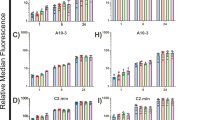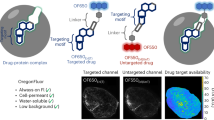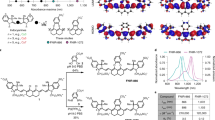Abstract
We have developed a versatile, potent technique for imaging cells in culture and in vivo by expressing a metabolically biotinylated cell-surface receptor and visualizing it with labeled streptavidin moieties. The recombinant reporter protein, which incorporates a biotin acceptor peptide (BAP) between an N-terminal signal sequence and a transmembrane domain, (BAP-TM) was efficiently biotinylated by endogenous biotin ligase in mammalian cells with the biotin displayed on the cell surface. Tumors expressing the BAP-TM have high sensitivity for magnetic resonance and fluorescence tomographic imaging in vivo after intravascular injection of streptavidin conjugated to magnetic nanoparticles or fluorochromes, respectively. Moreover, streptavidin–horseradish peroxidase conjugates in conjunction with a peroxidase-sensitive gadolinium agent further increased and prolonged the magnetic resonance signal. This BAP-TM allows noninvasive real-time imaging of any cell type transduced to express this reporter protein in culture or in vivo.
*Note: In the version of this article originally published, reference 12 was incorrect. The correct reference 12 is Querol, M., Chen, J.W., Weissleder, R. & Bogdanov, A. Jr. DTPA-bis-amide based MR sensor agents for peroxidase imaging. Org. Lett. 17, 1719–1722 (2005). This error has been corrected in the PDF version of the article.
This is a preview of subscription content, access via your institution
Access options
Subscribe to this journal
Receive 12 print issues and online access
$259.00 per year
only $21.58 per issue
Buy this article
- Purchase on Springer Link
- Instant access to full article PDF
Prices may be subject to local taxes which are calculated during checkout





Similar content being viewed by others
Change history
10 July 2006
change to reference
References
Gross, S. & Piwnica-Worms, D. Spying on cancer: molecular imaging in vivo with genetically encoded reporters. Cancer Cell 7, 5–15 (2005).
Tsien, R.Y. Building and breeding molecules to spy on cells and tumors. FEBS Lett. 579, 927–932 (2005).
Contag, C.H. & Ross, B.D. It's not just about anatomy: in vivo bioluminescence imaging as an eyepiece into biology. J. Magn. Reson. Imaging 16, 378–387 (2002).
Tannous, B.A., Kim, D.E., Fernandez, J.L., Weissleder, R. & Breakefield, X.O. Codon-optimized Gaussia luciferase cDNA for mammalian gene expression in culture and in vivo. Mol. Ther. 11, 435–443 (2005).
Tjuvajev, J.G. et al. Comparison of radiolabeled nucleoside probes (FIAU, FHBG, and FHPG) for PET imaging of HSV1-tk gene expression. J. Nucl. Med. 43, 1072–1083 (2002).
Weissleder, R. et al. In vivo magnetic resonance imaging of transgene expression. Nat. Med. 6, 351–355 (2000).
Che, J. et al. hNIS-IRES-eGFP dual reporter gene imaging. Mol. Imaging 4, 128–136 (2005).
Prescher, J.A. & Bertozzi, C.R. Chemistry in living systems. Nat. Chem. Biol. 1, 13–21 (2005).
Chapman-Smith, A. & Cronan, J.E., Jr. In vivo enzymatic protein biotinylation. Biomol. Eng. 16, 119–125 (1999).
Parrott, M.B. & Barry, M.A. Metabolic biotinylation of recombinant proteins in mammalian cells and in mice. Mol. Ther. 1, 96–104 (2000).
Diamandis, E.P. & Christopoulos, T.K. The biotin-(strept)avidin system: principles and applications in biotechnology. Clin. Chem. 37, 625–636 (1991).
Chen, J.W., Pham, W., Weissleder, R. & Bogdanov, A., Jr. Human myeloperoxidase: a potential target for molecular MR imaging in atherosclerosis. Magn. Reson. Med. 52, 1021–1028 (2004).
Chen, I., Howarth, M., Lin, W. & Ting, A.Y. Site-specific labeling of cell surface proteins with biophysical probes using biotin ligase. Nat. Meth. 2, 99–104 (2005).
Tannous, B.A., Laios, E. & Christopoulos, T.K. T7 RNA polymerase as a self-replicating label for antigen quantification. Nucleic Acids Res. 30, e140 (2002).
Tannous, B.A., Verhaegen, M., Christopoulos, T.K. & Kourakli, A. Combined flash- and glow-type chemiluminescent reactions for high-throughput genotyping of biallelic polymorphisms. Anal. Biochem. 320, 266–272 (2003).
Sakahara, H. & Saga, T. Avidin-biotin system for delivery of diagnostic agents. Adv. Drug Deliv. Rev. 37, 89–101 (1999).
Moore, A., Grimm, J., Han, B. & Santamaria, P. Tracking the recruitment of diabetogenic CD8+ T-cells to the pancreas in real time. Diabetes 53, 1459–1466 (2004).
Axworthy, D.B. et al. Cure of human carcinoma xenografts by a single dose of pretargeted yttrium-90 with negligible toxicity. Proc. Natl. Acad. Sci. USA 97, 1802–1807 (2000).
Kirkeby, S., Moe, D., Bog-Hansen, T.C. & van Noorden, C.J. Biotin carboxylases in mitochondria and the cytosol from skeletal and cardiac muscle as detected by avidin binding. Histochemistry 100, 415–421 (1993).
Martin, B.R., Giepmans, B.N., Adams, S.R. & Tsien, R.Y. Mammalian cell-based optimization of the biarsenical-binding tetracysteine motif for improved fluorescence and affinity. Nat. Biotechnol. 23, 1308–1314 (2005).
McCann, C.M., Bareyre, F.M., Lichtman, J.W. & Sanes, J.R. Peptide tags for labeling membrane proteins in live cells with multiple fluorophores. Biotechniques 38, 945–952 (2005).
Sena-Esteves, M., Tebbets, J.C., Steffens, S., Crombleholme, T. & Flake, A.W. Optimized large-scale production of high titer lentivirus vector pseudotypes. J. Virol. Methods 122, 131–139 (2004).
Hewett, J. et al. Mutant torsinA, responsible for early-onset torsion dystonia, forms membrane inclusions in cultured neural cells. Hum. Mol. Genet. 9, 1403–1413 (2000).
Perez, J.M., Josephson, L., O'Loughlin, T., Hogemann, D. & Weissleder, R. Magnetic relaxation switches capable of sensing molecular interactions. Nat. Biotechnol. 20, 816–820 (2002).
Rusckowski, M., Fogarasi, M., Fritz, B. & Hnatowich, D.J. Effect of endogenous biotin on the applications of streptavidin and biotin in mice. Nucl. Med. Biol. 24, 263–268 (1997).
Rosset, A., Spadola, L. & Ratib, O. OsiriX: an open-source software for navigating in multidimensional DICOM images. J. Digit. Imaging 17, 205–216 (2004).
Montet, X., Ntziachristos, V., Grimm, J. & Weissleder, R. Tomographic fluorescence mapping of tumor targets. Cancer Res. 65, 6330–6336 (2005).
Ntziachristos, V., Tung, C.H., Bremer, C. & Weissleder, R. Fluorescence molecular tomography resolves protease activity in vivo. Nat. Med. 8, 757–760 (2002).
Grimm, J. et al. Use of gene expression profiling to direct in vivo molecular imaging of lung cancer. Proc. Natl. Acad. Sci. USA 102, 14404–14409 (2005).
Acknowledgements
This work was supported by grants from the US National Cancer Institute CA69246 (X.O.B. and R.W.), CA86355 (R.W. and X.O.B.), CA92782 (R.W.), U01 HL080731 (R.W.), R01 HL078641 (R.W.) and the Brain Tumor Society (X.O.B. and B.A.T.). We thank M. Sena-Esteves (MGH) for providing the lentivirus vectors, P. Waterman for FMT analysis, S. Rhee for magnetic resonance image acquisitions, M. Pittet for help with FACS analysis, N. Sergeyev for synthesizing MNP and F. Reynolds for synthesizing the Gd agent. We also thank S. McDavitt and M. Carlson for editorial assistance.
Author information
Authors and Affiliations
Corresponding author
Ethics declarations
Competing interests
The authors declare no competing financial interests.
Rights and permissions
About this article
Cite this article
Tannous, B., Grimm, J., Perry, K. et al. Metabolic biotinylation of cell surface receptors for in vivo imaging. Nat Methods 3, 391–396 (2006). https://doi.org/10.1038/nmeth875
Received:
Accepted:
Published:
Issue Date:
DOI: https://doi.org/10.1038/nmeth875
This article is cited by
-
Computationally designed dual-color MRI reporters for noninvasive imaging of transgene expression
Nature Biotechnology (2022)
-
A bacterial display system for effective selection of protein-biotin ligase BirA variants with novel peptide specificity
Scientific Reports (2019)
-
Monitoring hippocampal glycine with the computationally designed optical sensor GlyFS
Nature Chemical Biology (2018)
-
Surface biotinylation of cytotoxic T lymphocytes for in vivo tracking of tumor immunotherapy in murine models
Cancer Immunology, Immunotherapy (2016)
-
Multimodal targeted high relaxivity thermosensitive liposome for in vivo imaging
Scientific Reports (2015)



